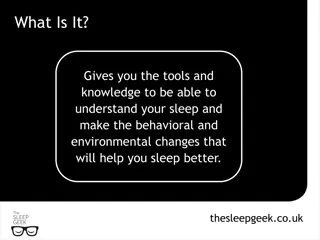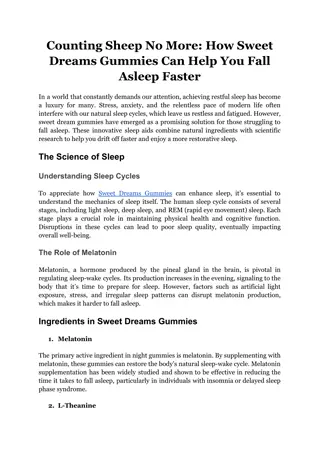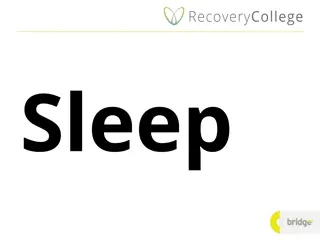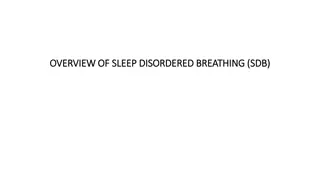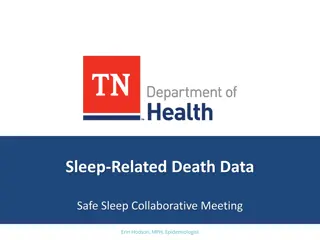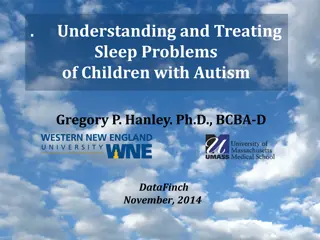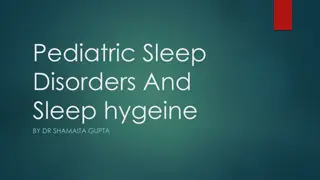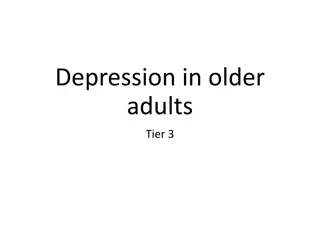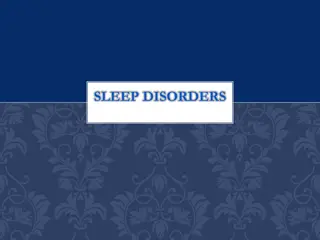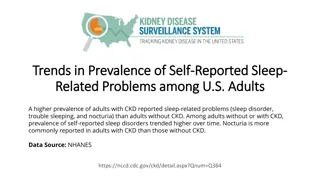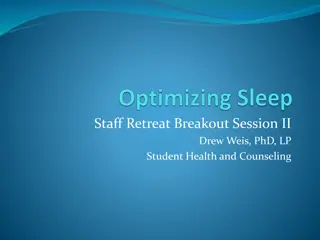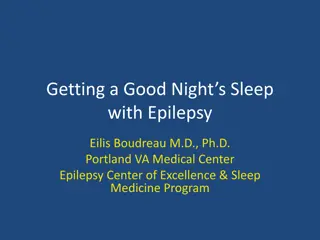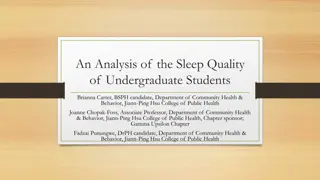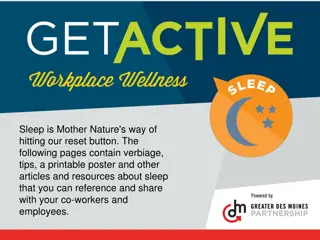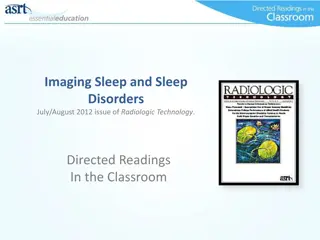Understanding Sleep Problems in Older Adults
Sleep problems are common among older adults, especially those with chronic illnesses and mood disturbances. Primary sleep disorders that increase with age include sleep-related breathing disorders and restless legs syndrome. Changes in sleep patterns with aging involve decreases in total sleep time and sleep efficiency, while daytime napping may increase. Evaluation of sleep involves screening questions and office assessments, including sleep logs and mental status testing. It's essential to address sleep issues in older individuals to improve their quality of life.
Download Presentation

Please find below an Image/Link to download the presentation.
The content on the website is provided AS IS for your information and personal use only. It may not be sold, licensed, or shared on other websites without obtaining consent from the author. Download presentation by click this link. If you encounter any issues during the download, it is possible that the publisher has removed the file from their server.
E N D
Presentation Transcript
Sleep Problems Alfred Fisher MD PhD Professor and Chief Division of Geriatrics, Gerontology, and Palliative Medicine Department of Internal Medicine University of Nebraska Medical Center
SLEEP PROBLEMS IN OLDER PEOPLE Sleep problems are common in older adults, particularly those with comorbid medical conditions and psychiatric illness Risk Factors for Sleep Disturbance: Chronic illness Multiple medical problems Mood disturbance Less physical activity Physical disability
SLEEP PROBLEMS IN OLDER PEOPLE Primary sleep disorders that increase with age: Sleep-related breathing disorders (eg, sleep apnea) Restless legs syndrome Circadian rhythm sleep disorders Insomnia is more common in women than in men at all ages Self-reported sleeping difficulties are more common in older African Americans, particularly women and in those with depression and chronic illness
CHANGES IN SLEEP WITH AGING Sleep Characteristic Age-Related Change Total sleep time Decrease Sleep latency (time to fall asleep) Sleep efficiency (time asleep over time in bed) Daytime napping Increase or no change Decrease Increase Stages N1 and N2 Increase Slow-wave sleep (Stage N3) Percent rapid eye movement (REM) Wake after sleep onset Decrease Decrease Increase
EVALUATION OF SLEEP Screening Questions: Is the person satisfied with his or her sleep? Does sleep or fatigue interfere with daytime activities? Does the bed partner or others complain of unusual behavior during sleep, such as snoring, interrupted breathing, or leg movements?
OFFICE EVALUATION OF SLEEP Patient sleep log can be helpful -Supplement with information from bed partner, others, and/or validated sleep questionnaire Focused physical exam guided by evidence from the history Conduct mental status testing with a focus on memory and mood problems, particularly depression Lab testing guided by findings of the history and physical exam
OBJECTIVE EVALUATION OF SLEEP Polysomnography is indicated if primary sleep disorder is suspected: Sleep apnea Narcolepsy Periodic limb movement disorder Violent or other unusual behaviors during sleep Other sleep symptoms that do not respond to treatment In-home portable monitoring screens for sleep apnea
INSOMNIA Depression and anxiety are common psychiatric problems that are associated with insomnia Treatment of depression may improve the sleep abnormalities Lack of attention to sleep complaints in older depressed adults can make depression less likely to respond to treatment Caregiving can be associated with sleep difficulties Sleep disorders in older adults are associated with increased suicide risk Can be secondary to medical conditions or medications
MEDICATIONS ASSOCIATED WITH INSOMNIA Medications/agents that can contribute to insomnia, particularly if taken near bedtime: Agents that increase urination (eg, diuretics) Stimulating agents (eg, caffeine, sympathomimetics, bronchodilators, activating psychiatric medications) Agents that can cause nightmares and impair sleep Antidepressants Antiparkinsonian agents Antihypertensives (eg, propranolol) Cholinesterase inhibitors
MANAGEMENT OF INSOMNIA Do not start an older patient with persistent sleep complaints on a sedative-hypnotic agent without careful clinical assessment to identify the cause of the complaints If the history and physical exam do not suggest a serious underlying cause, mild symptoms may respond to simple sleep hygiene Chronic insomnia generally does not respond to simple sleep hygiene, and requires behavioral treatment, such as cognitive behavioral therapy for insomnia (CBT-I) Patients should be educated that daytime napping will decrease nighttime sleep
WHAT IS INCLUDED IN CBT-I? Intervention Goal Description Stimulus control To recondition maladaptive sleep-related behaviors Patient is told to go to bed only when sleepy, not use the bed for eating or watching TV, get out of bed if unable to fall asleep, return to bed only when sleepy, get up at the same time each morning, not take naps during the day Sleep restriction To improve sleep efficiency (time asleep divided by time in bed) by causing sleep deprivation Patient first collects a 1- to 2-week sleep diary to determine average total daily sleep time, then stays in bed only that duration plus ~ 15 minutes, gets up at same time each morning, takes no naps in the daytime, gradually increases time allowed in bed as sleep efficiency improves
WHAT IS INCLUDED IN CBT-I? Intervention Goal Description Cognitive interventions To change misunderstandings and false beliefs regarding sleep Identify patient s dysfunctional beliefs and attitudes about sleep; educate patient to change these false beliefs and attitudes, including normal changes in sleep with increased age and changes that are pathologic Relaxation techniques To recognize and relieve tension and anxiety Teach patient to tense and relax each muscle group. Electromyographic biofeedback: give patient feedback regarding muscle tension and teach techniques to relieve it. Teach meditation or imagery techniques to relieve racing thoughts or anxiety.
RESTLESS LEGS SYNDROME Characterized by an uncontrollable urge to move the legs, usually with an unpleasant sensation in the legs, that worsens with inactivity, generally at night, and improves with movement Diagnosis is made based on the patient s description of the symptoms Symptoms occur while the person is awake and can also involve the arms Prevalence increases with age Can be associated with iron deficiency can check ferritin level to assess
RESTLESS LEGS SYNDROME Medications can also aggravate or induce RLS: Antiemetics Antipsychotics SSRIs Tricyclic Antidepressants Diphenydramine These medications should be addressed in patients with new or worsening RLS
TREATMENT OF RESTLESS LEGS SYNDROME Treat RLS if symptoms are severe or if quality of life is impacted A dopaminergic agent is generally the initial agent of choice for older patients Evening dose of a dopamine agonist (eg, pramipexole or ropinirole) is commonly used for patients with frequent (eg, nightly) symptoms of RLS Gabapentin is an alternative for those who cannot tolerate a dopamine agonist
SUMMARY Sleep issues are common in older individuals and can be evaluated in a step-wise manner Insomnia can respond well to non-pharmacologic interventions including improved sleep hygiene and/or CBT-I Restless legs is associated with iron deficiency and can respond to dopamine agonists or gabapentin





